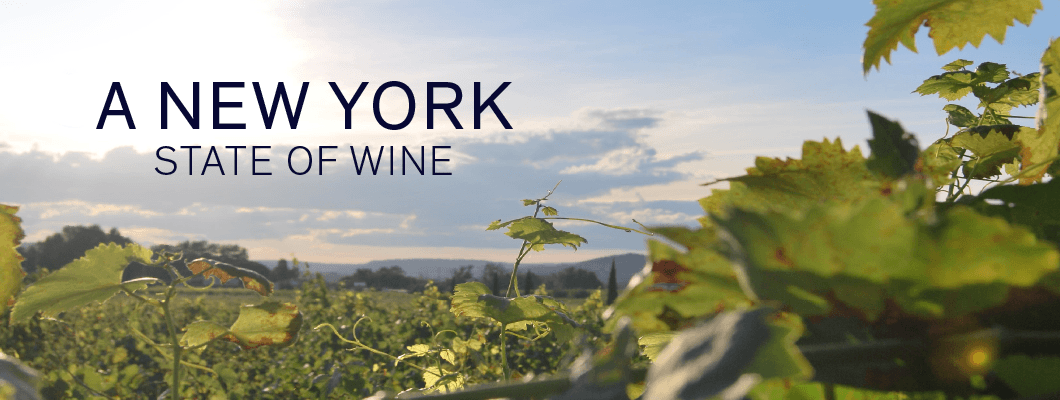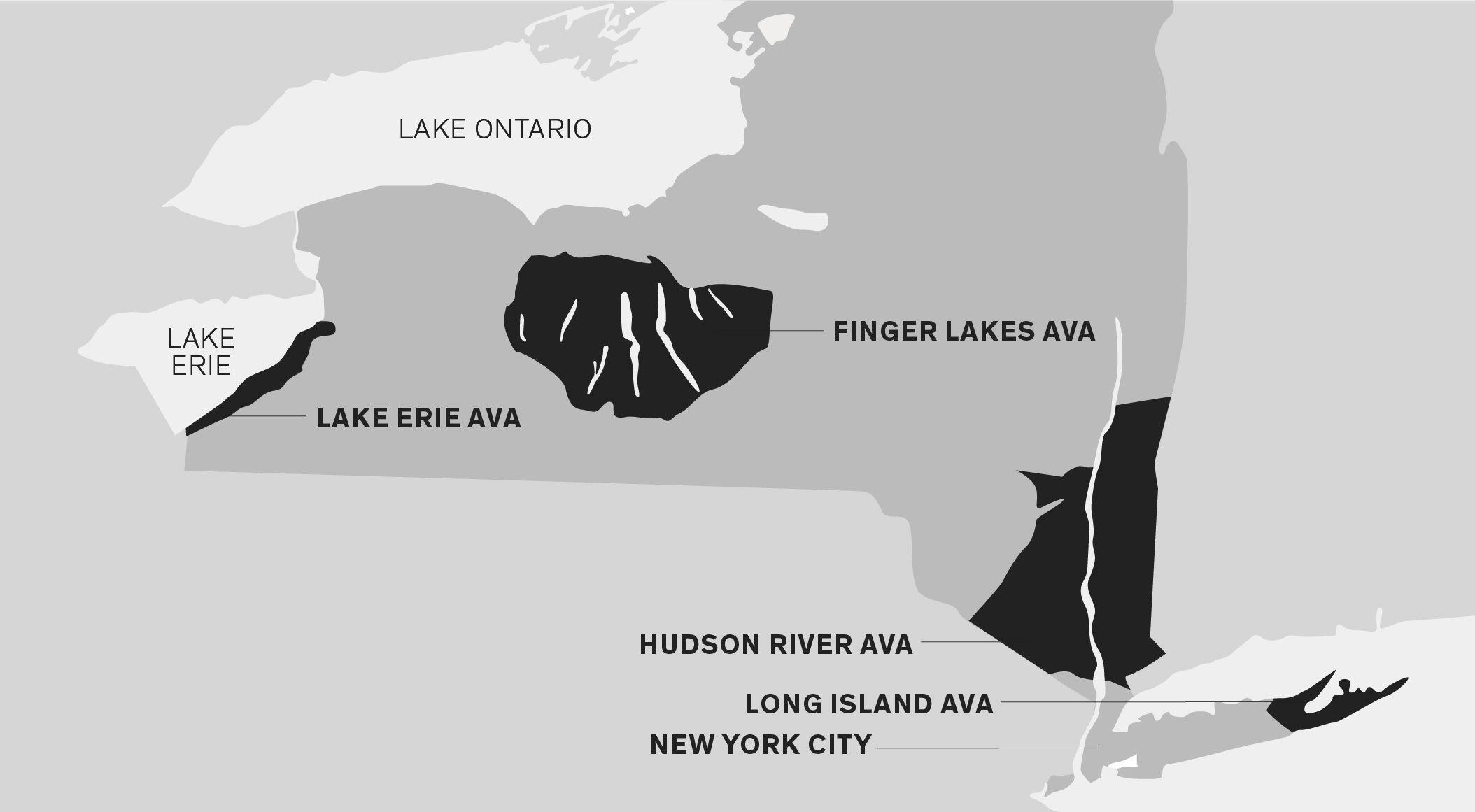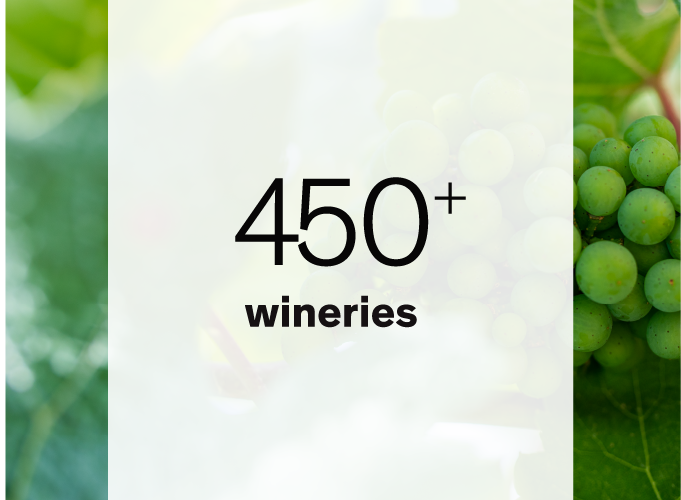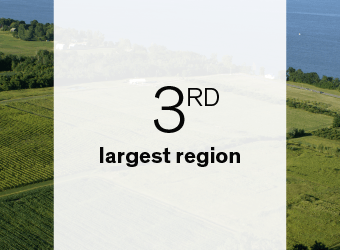
Bold. Diverse. Nuanced.
With its unique blend of tradition and ingenuity, New York offers up a wine for every palate.
From the furthest reaches of Long Island, winding up through the Hudson Valley and stretching all the way east to Niagara and the southern shores of Lake Erie, New York is awash in grapes. Wine has been made in the state since the 17th century, but the commercial industry only began in the 1800s, producing mostly native North American varietals. Starting in the 1950s, though, a move toward European vinifera grapes began to take hold and today, the state is gaining a reputation as one of the New World’s most exciting up-and-coming wine regions. Winemakers here are known for embracing tradition while celebrating new ideas. The result? A deliciously surprising variety of wines to discover.
Wines to Try
Fine New York wines from Vintages
Try these new releases – here for a limited time only.
Regions to Know


Lake Erie AVA
With 23 wineries and counting, this vast American Viticultural Area (AVA) is America’s largest grape-growing region outside California. Long a source of Concord grape juice, the region is now turning its attention to classic vinifera varietals and is becoming especially well-known for the quality of its Riesling, as well as hybrid grapes like Noiret and Seyval Blanc.

Finger Lakes AVA
Traditionally, the region’s vineyards have been centred around four lakes — Cayuga, Canandaigua, Keuka and Seneca — but more recently, smaller lakes further east have seen new vineyards planted. These lakes provide the moderating influence that makes the area so well-suited to producing exceptional sparkling wines (Chardonnay, Riesling, Pinot Noir and Cabernet Franc), as well as Icewine.

Hudson River AVA
This AVA is an historically important one. Considered America’s oldest winery, Brotherhood Winery was founded in 1839 and continues to be an innovation leader. Chardonnay, Cabernet Franc and Seyval Blanc ripen especially well in the lush river valley, hemmed in by the rolling Shawangunk Mountains to the west and the Dutchess and Westchester counties to the east.

Long Island AVA
This relatively new AVA was created in 2001, although there have been wineries in the area since the ’70s. Hot summers tempered by the region’s proximity to the Atlantic Ocean make it a prime spot for growing Bordelaise varietals like Sauvignon Blanc, Cabernet Franc and Merlot — the latter two often blended together into Meritage wines.
Fast Facts

Over 450 wineries
Almost 400 of NY's wineries have opened in the last 50 years. The state is also home to 1,600 family-owned vineyards.

First grapes planted by Dutch settlers
New York's wine history stretches back to the 17th century. Today, innovative producers come from near and far to make wine here.

35,000 acres of vineyards
New York is the third-largest wine-producing state in the US and grows more than 40 grape varieties. Almost 5 million tourists visit NY wineries each year.

3 Great Reds

Cabernet Sauvignon
Much of New York’s Cabernet Sauvignon production is found on Long Island. As is typical for the grape, the wines are big, bold and rich, with dried cherry and cassis notes. Firm, silky tannins are often present, making these wines closer in style to those from Bordeaux than California wines, while revealing their own unique terroir.
TRY IT WITH: AAA New York strip, of course

Cabernet Franc
Used primarily as a blending grape in France (where it originated), this ancient varietal has established itself as a signature red grape throughout New York but does especially well in the Hudson Valley. More herbaceous and lighter in colour than its cousin, Cabernet Sauvignon, Cabernet Franc is an extremely versatile and food-friendly wine that sometimes exudes orange peel, cigar box and leather aromas, backed by plenty of briar fruit and vanilla notes.
TRY IT WITH: Barbecued Potato & Sausage Salad

Merlot
Another French grape that’s showing great character in New York soil, Merlot is considered Long Island’s signature varietal. Combining ripeness and richness with acidity and structure makes for powerful, age-worthy wines. Black cherry and chocolate flavours are often pronounced, along with a pleasant earthiness supported by violet, baking spice and licorice aromas.
TRY IT WITH: Baked Chicken and Mushrooms
3 Wonderful Whites

Riesling
This German varietal is considered the signature grape of the Finger Lakes region, which is responsible for nearly 90% of New York’s total production. Initially planted back in the 1950s, it was one of the first European vinifera grapes to find success in the state and helped drive the trend toward more refined, modern winemaking. Ranging in style from bone-dry and crisp to floral and sweet, Riesling’s versatility is part of its charm. Pear, apple, melon and almond flavours and aromas are common, carried on fresh acidity.
TRY IT WITH: Thai red curry with coconut milk

Chardonnay
New York Chardonnay tends to be styled somewhere between traditional French Chablis (crisp, acidic, bright) and classic California versions (voluptuous, rich, oaky). Lemon curd and honeydew melon flavours are typical and carried by a rich, mouth-filling texture. Oak-aged versions might express more vanilla and tropical fruit flavours, while stainless-steel-aged examples tend to accentuate the grape’s freshness.
TRY IT WITH: Mushroom Risotto

Gewurztraminer
There is a lot of buzz in wine circles suggesting that Gewurztraminer might just be New York’s next big thing. Red-skinned but producing white wines, the grape is aromatic with a touch of spiciness. The medium-bodied wine often displays peach and citrus characteristics, along with more exotic fruit notes like lychee and papaya.
TRY IT WITH: Pork souvlaki with tzatziki or a classic barbecued chicken